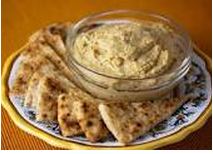By Catharine L. Kaufman—a.k.a. The Kitchen Shrink
If you wonder what the common link might be between the dictionary’s dual definitions of “humus or hummus” as “(1) soil with partly decomposed organic matter; and (2) Middle Eastern dish made with chickpeas, garlic, olive oil & other ingredients,” you might consider that both fertile soil and that popular dish possess life-sustaining substances.
Cultivated for millennia throughout the Mediterranean regions, India and even, according to ancient culinary historians, in the Hanging Gardens of Babylon, the prolific chickpea—also known as garbanzo bean or Egyptian pea—has been used as the basic ingredient for this versatile comfort food. Enjoyed as a savory dip or served as a hearty side-dish, hummus is puréed and enriched with olive oil, chopped fresh garlic, lemon juice, tahini paste made of sesame seeds and various herbs and spices that reflect the preferences of countless local cuisines around the Mediterranean Sea—as well as its popularity as a street food in the Roman Empire and Mesopotamia.
The Big Dip Challenge
With such a universal appeal, it’s no wonder that still unresolved historical disputes continue to this day among nations, tribes and ethnic groups, each of which claims ownership of whatever they consider the ‘original’ hummus recipe.
Almost a decade ago the Association of Lebanese Industrialists petitioned the Ministry of Economy and Trade to seek protective status for hummus from the European Commission, as a uniquely Lebanese food. Possibly prompted by Israel’s lucrative export market of hummus (Sabra products), the organization charged that its political rival has usurped the national dish of Lebanon. A year later, the two nations chose a non-violent resolution to their culinary conflict by staging a public competition to build the largest (but still probably tasty) bowl of hummus. Israel’s well-seasoned 9,000-pound creation was decisively out-hummussed by Lebanon’s gargantuan bowl of a delicious, Guinness World Record-winning entry, that weighed in at 14,000 pounds.
Variations On Hummus Flavor Themes
Since the foodie revolution of the last several decades, creative chefs have been coming up with ever more interesting recipes by adding chopped fresh parsley and basil, sweet paprika, cayenne, caper-berries and other exotic ingredients to this versatile dip.
Organic hummus is now the rage, not only because it is healthier, but according to many consumers, much tastier. Seductive flavors and additional health advantages are among the selling points of hummus variations blended with hot Mexican chili pepper, avocado, Feta cheese, chopped Kalamata olives and whatever else international food-jockeys dream up.
The Health Angle
This creamy, savory, spreadable and spoonable dish also packs some serious nutritional punch, which includes digestive fiber, folate, immune-boosting Vitamin-C, potassium, iron and calming, brain-nourishing B6. The sesame seed-based tahini adds the amino acid methionine, which further boosts the chickpeas’ protein component. Combining hummus with organic (or at least non-GMO) pita bread, tabouli (tabbouleh) made with bulgur wheat or other grain-based product, creates a powerful vegetarian source of whole-protein.
Hummus Platters For Adventurous Taste Buds
Audacious diners experiment with hummus spread on sourdough toast topped with roasted peppers; or delighte taste buds with a multi-colored and multi-flavored platter of hummus, roasted eggplant babaganoush, sweet-and-sour braised kale, sliced avocado, sunny-side-up or sliced hardboiled egg, a side of edamame lightly sprinkled with balsamic vinegar, roasted baby potatoes, cold slices of baked chicken breast, smoked wild-caught salmon or whatever else foodie taste buds crave.
Home-Made Hummus Inspired By Belly Dancer:(See Ha Ha Hummus)
Recipe: Roasted Garlic Hummus (preferably, all organic ingredients)
- 4 cups chickpeas—canned, drained, (skins removed if preferred by covering raw chickpeas with water and a teaspoon of baking powder for an hour; boiling and simmering them until tender (about 90 minutes), draining them and removing their skins)
- 2 cups tahini
- juice of one lemon
- ¼ cup extra virgin olive oil
- 4 fresh garlic cloves
- salt (preferably pink Himalayan salt) and black or cayenne pepper to taste
Preparation:
- Turn oven to moderate heat—place garlic cloves on parchment-lined oven-proof dish; drizzle with olive oil; sprinkle salt; bake until tender; set aside
- Place chickpeas in food processor and pulse a few times; add garlic, tahini, lemon juice, more salt if needed and pepper; pulse until creamy smooth; add more olive oil and blend on ‘gentle’ cycle
- If hummus is too thick, add ice water for desired consistency
- Transfer to a decorative bowl and garnish with sliced olives, chopped parsley, Persian cucumber slices and paprika.

